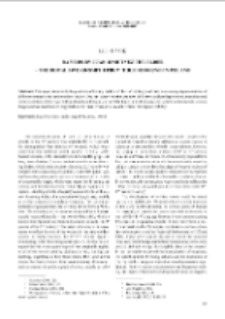
Obiekt
Tytuł: Rapiers by Juan Martinez the Elder – the royal sword-smith from Toledo found in Poland
Inny tytuł:
Fasciculi Archaeologiae Historicae. Fasc. 27 (2014)
Wydawca:
Institute of Archaeology and Ethnology of Polish Academy of Sciences ; Polish Academy of Sciences. Łódź Branch
Miejsce wydania:
Opis:
Typ obiektu:
Abstrakt:
The paper deals with the problem of luxury rapiers of the 16th century and their use among representatives of different stratas in the early modern society. One can observe on the example of the two analyzed specimens, manufactured in the workshop of the royal Toledan bladesmith Juan Martinez the Elder, how the increase in wealth and prosperity among burgesses has lead them to copy fashion for luxury weapons and attire from the highest nobility
Bibliografia:
Anglo S. 2000. The Martial Arts of Renaissance Europe. New Heaven, London
Baart J., Krook W., Langerweij Ab., Ockers N., Regteren Altena van H., Stam T., Stoepker H. Stouthart G., Zwan van der M. 1977. Opgravingen in Amsterdam. 20 jaar stadskernonderzoek. Amsterdam
Beard Ch. R. 1961. The Spinola Sword. „Journal of the Arms and Armour Society” 3/11, 273-283
Boeheim W. 1897. Meister der Waffenschmiedkunst vom XIV bis ins XVIII Jahrhundert. Berlin
Dueñas Beraiz G. 2004. Introducción al Estudio Tipológico de las Espadas Españolas: Siglos XVI-XVII. „Gladius“ 24, 209-260
http://gladius.revistas.csic.es/index.php/gladius/article/view/42/43 -
Ekstrand G. 1968. Eine englische Degentasche aus der Rüstkammer Gustav II. Adolf von Schweden. „Waffen und Kostümkunde” 17, 52-61
Geibig A. 2009. Gefärlich und Schön. Coburg
Godoy J. A., Leydi S. 2003. Parures triomphales: le manierisme dans dans l‘art de l‘armure italienne. Genèv
Goliński M., Żerelik R. 1993. Inwentarze zbrojowni i arsenału księcia legnickiego Ludwika IV z lat 1662-1669. Legnica
Grancsay S.V. 1947. The Sword of Ambrogio di Spinola. „The Metropolitan Museum of Art Bulletin”, New Series 5/9, 235-239
http://www.jstor.org/stable/3257316?origin=crossref&seq=1#page_scan_tab_contents –
Hohenschwert F. 1984. Fundchronik: Mittelalter/Neuzeit, Barntrup, Kr. Lippe. „Ausgrabungen und Funde in Westfallen – Lippe“ 2, 263-268
Iwańczak W. 2000. Peasants in the medieval bohemian army. „Fasciculi Archaeologiae Historicae“ 12, 15-20
Lieber E. 1979/1980. Frühe Eisenschnittdegen im Historischen Museum Dresden. „Jahrbuch der Staatlichen Kunstsammlungen Dresden“ 42, 117-158
Mann J. 1962. European Arms and Armour. Wallace Collection Catalogues. European Arms and Armour II. Arms. London
Martens I. 2002. Viking Age Weapons in Norway. Their Role in Society. In: C. Olsson (ed.), XVI IAMAM Congress 2002: Proceedings, 9-16 June, Oslo, Norway. Oslo, 114-121
Norman A. V. B. 1980. The Rapier and Small-Sword 1460-1820. North Stratford
Oakeshott E. 2000. European Weapons and Armour. Woodbridge
Peláez Valle J. M. 1983. La Espada Ropera Española en los Siglos XVI y XVII. „Gladius” 16, 147-199
http://gladius.revistas.csic.es/index.php/gladius/article/view/127/127 -
Prokop K. R. 1999. Jan Chrystian. In: S. Szczur and K. Ożóg (eds.), Piastowie. Leksykon biograficzny. Kraków, 536-540
Schöbel J. 1973. Prunkwaffen. Leipzig
Seitz H. 1965. Blankwaffen I. Braunschweig
Włodarski J. 1997. Losy polityczne (1626-1772). In: A. Groth (ed.), Historia Elbląga II/2 (1626-1772 r.). Gdańsk, 5-65
Czasopismo/Seria/cykl:
Fasciculi Archaeologiae Historicae
Tom:
Strona pocz.:
Strona końc.:
Szczegółowy typ zasobu:
Format:
Identyfikator zasobu:
oai:rcin.org.pl:54821 ; 0860-0007
Źródło:
IAiE PAN, sygn. P III 368 ; IAiE PAN, sygn. P III 348 ; IAiE PAN, sygn. P III 349 ; kliknij tutaj, żeby przejść
Język:
Język streszczenia:
Prawa:
Prawa zastrzeżone - dostęp nieograniczony
Zasady wykorzystania:
Digitalizacja:
Instytut Archeologii i Etnologii Polskiej Akademii Nauk
Lokalizacja oryginału:
Biblioteka Instytutu Archeologii i Etnologii PAN
Dostęp:
Kolekcje, do których przypisany jest obiekt:
- Repozytorium Cyfrowe Instytutów Naukowych > Kolekcje Partnerów > Instytut Archeologii i Etnologii PAN > Publikacje Pracowników i Wydawnictwa IAE PAN
- Repozytorium Cyfrowe Instytutów Naukowych > Kolekcje Partnerów > Instytut Archeologii i Etnologii PAN > Publikacje Pracowników i Wydawnictwa IAE PAN > Czasopisma bieżące
- Repozytorium Cyfrowe Instytutów Naukowych > Piśmiennictwo > Czasopisma/Artykuły
- Repozytorium Cyfrowe Instytutów Naukowych > Kolekcje Partnerów > Instytut Archeologii i Etnologii PAN > Publikacje Pracowników i Wydawnictwa IAE PAN > Czasopisma bieżące > Fasciculi Archaeologiae Historicae
Data ostatniej modyfikacji:
9 kwi 2021
Data dodania obiektu:
14 lip 2015
Liczba pobrań / odtworzeń:
1957
Wszystkie dostępne wersje tego obiektu:
https://rcin.org.pl/publication/75173
Wyświetl opis w formacie RDF:
Wyświetl opis w formacie RDFa:
Wyświetl opis w formacie OAI-PMH:
| Nazwa wydania | Data |
|---|---|
| Marek, Lech, 2014, Rapiers by Juan Martinez the Elder – the royal sword-smith from Toledo found in Poland | 9 kwi 2021 |
Obiekty Podobne
Zakrzewski, Zygmunt (1867–1951)
Głosek, Marian (1941– )
Kucypera, Paweł Hošek, Jiří
Kirpičnikov, Anatolij Nikolaevič (1929– )
Żabiński, Grzegorz Stępiński, Janusz
Ościłowski, Jarosław
Chemodanova, Olena
Żak, Jan (1923–1990)

 INSTYTUT ARCHEOLOGII I ETNOLOGII POLSKIEJ AKADEMII NAUK
INSTYTUT ARCHEOLOGII I ETNOLOGII POLSKIEJ AKADEMII NAUK
 INSTYTUT BADAŃ LITERACKICH POLSKIEJ AKADEMII NAUK
INSTYTUT BADAŃ LITERACKICH POLSKIEJ AKADEMII NAUK
 INSTYTUT BADAWCZY LEŚNICTWA
INSTYTUT BADAWCZY LEŚNICTWA
 INSTYTUT BIOLOGII DOŚWIADCZALNEJ IM. MARCELEGO NENCKIEGO POLSKIEJ AKADEMII NAUK
INSTYTUT BIOLOGII DOŚWIADCZALNEJ IM. MARCELEGO NENCKIEGO POLSKIEJ AKADEMII NAUK
 INSTYTUT BIOLOGII SSAKÓW POLSKIEJ AKADEMII NAUK
INSTYTUT BIOLOGII SSAKÓW POLSKIEJ AKADEMII NAUK
 INSTYTUT CHEMII FIZYCZNEJ PAN
INSTYTUT CHEMII FIZYCZNEJ PAN
 INSTYTUT CHEMII ORGANICZNEJ PAN
INSTYTUT CHEMII ORGANICZNEJ PAN
 INSTYTUT FILOZOFII I SOCJOLOGII PAN
INSTYTUT FILOZOFII I SOCJOLOGII PAN
 INSTYTUT GEOGRAFII I PRZESTRZENNEGO ZAGOSPODAROWANIA PAN
INSTYTUT GEOGRAFII I PRZESTRZENNEGO ZAGOSPODAROWANIA PAN
 INSTYTUT HISTORII im. TADEUSZA MANTEUFFLA POLSKIEJ AKADEMII NAUK
INSTYTUT HISTORII im. TADEUSZA MANTEUFFLA POLSKIEJ AKADEMII NAUK
 INSTYTUT JĘZYKA POLSKIEGO POLSKIEJ AKADEMII NAUK
INSTYTUT JĘZYKA POLSKIEGO POLSKIEJ AKADEMII NAUK
 INSTYTUT MATEMATYCZNY PAN
INSTYTUT MATEMATYCZNY PAN
 INSTYTUT MEDYCYNY DOŚWIADCZALNEJ I KLINICZNEJ IM.MIROSŁAWA MOSSAKOWSKIEGO POLSKIEJ AKADEMII NAUK
INSTYTUT MEDYCYNY DOŚWIADCZALNEJ I KLINICZNEJ IM.MIROSŁAWA MOSSAKOWSKIEGO POLSKIEJ AKADEMII NAUK
 INSTYTUT PODSTAWOWYCH PROBLEMÓW TECHNIKI PAN
INSTYTUT PODSTAWOWYCH PROBLEMÓW TECHNIKI PAN
 INSTYTUT SLAWISTYKI PAN
INSTYTUT SLAWISTYKI PAN
 SIEĆ BADAWCZA ŁUKASIEWICZ - INSTYTUT TECHNOLOGII MATERIAŁÓW ELEKTRONICZNYCH
SIEĆ BADAWCZA ŁUKASIEWICZ - INSTYTUT TECHNOLOGII MATERIAŁÓW ELEKTRONICZNYCH
 MUZEUM I INSTYTUT ZOOLOGII POLSKIEJ AKADEMII NAUK
MUZEUM I INSTYTUT ZOOLOGII POLSKIEJ AKADEMII NAUK
 INSTYTUT BADAŃ SYSTEMOWYCH PAN
INSTYTUT BADAŃ SYSTEMOWYCH PAN
 INSTYTUT BOTANIKI IM. WŁADYSŁAWA SZAFERA POLSKIEJ AKADEMII NAUK
INSTYTUT BOTANIKI IM. WŁADYSŁAWA SZAFERA POLSKIEJ AKADEMII NAUK


































